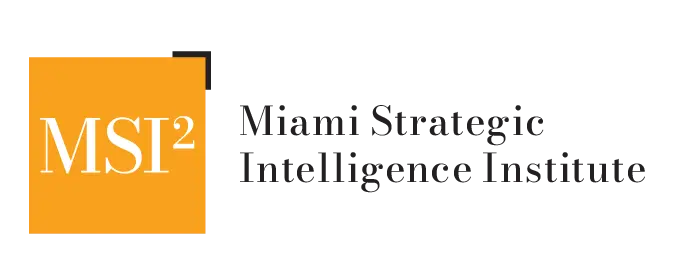18 Mar Analysis of U.S. Strategic Engagement in Latin America for Critical Raw Materials
By,
Dr. Rafael Marrero, Chief Economist — Senior Fellow and Founder | MSI2
Prepared Using the Defense Intelligence Agency (DIA) Open-Source Analysis Model.
1. Define the Problem
The global competition for critical raw materials (CRMs) such as lithium, cobalt, nickel, and rare earth elements (REEs) is intensifying. China and Russia continue leveraging their dominance in CRM supply chains to expand geopolitical and economic influence. Historically, Latin America (LATAM) has served as a strategic partner for the U.S. in securing these essential resources for defense, energy, and advanced technologies.
However, Secretary of State Marco Rubio’s recent announcement regarding a U.S. pivot to sourcing critical minerals from Ukraine instead of Latin America marks a strategic shift. While this move seeks to reinforce Ukraine’s economic recovery and reduce reliance on adversarial suppliers, it presents significant economic and geopolitical risks for LATAM, potentially undermining U.S. influence in the region and strengthening China’s foothold.
2. Collect Information
Key Data Points:
1. LATAM’s Critical Raw Materials:
o Lithium Triangle (Chile, Argentina, Bolivia): Over 50% of the world’s lithium reserves, essential for electric vehicles (EVs) and renewable energy.
o Brazil: A leading producer of nickel, cobalt, and REEs, crucial for defense and high tech industries.
o Mexico: Emerging deposits of lithium and REEs, presenting growth opportunities.
o Peru and Chile: Major copper producers, vital for electrical infrastructure and renewable energy transition.
2. Adversarial Influence:
o China: Dominates global REE refining and has secured vast mining interests in LATAM through its Belt and Road Initiative (BRI).
o Russia: Uses political instability to strengthen ties with resource-rich nations, such as Venezuela, and could exploit U.S. disengagement.
3. U.S. Challenges in LATAM:
o Insufficient U.S. infrastructure investment in CRM extraction and processing.
o Growing socio-environmental opposition to large-scale mining projects.
o Political instability affecting resource agreements.
3. Analyze Information
Implications of the U.S. Pivot to Ukraine:
• Economic Consequences for LATAM:
o Loss of Investment & Revenue: Countries like Brazil, Argentina, Chile, and Bolivia may experience reduced foreign investment and export revenues.
o Reduced Mining Expansion: A decline in U.S. demand could slow infrastructure development, affecting employment and local economies.
• Geopolitical Risks:
o China’s Increased Influence: Beijing could expand its dominance in LATAM’s CRM markets, further securing its control over global supply chains.
o Diminished U.S. Influence: The U.S. risks losing strategic leverage in the region, potentially pushing LATAM governments toward trade agreements with China, Russia, or the EU.
• Supply Chain Risks:
o LATAM Retaliation: Countries could impose export restrictions or increase prices on remaining U.S. trade.
o Ukraine’s Infrastructure Challenges: Ukraine currently lacks the extraction and processing capabilities LATAM provides, making the shift uncertain and slow.
• Environmental & Social Impact:
o Mining Slowdown: Reduced activity in LATAM could lessen ecological damage in sensitive regions like the Amazon and Lithium Triangle.
o Social Unrest: Job losses in mining-dependent communities could trigger instability and political volatility.
4. Generate and Evaluate Hypotheses
Hypothesis 1: U.S. disengagement from LATAM CRMs strengthens China and Russia’s foothold.
• Probability: High—China and Russia have established long-term agreements and economic ties with LATAM nations.
• Impact: Severe—A shift away from LATAM weakens U.S. influence, increasing dependency on adversarial-controlled supply chains.
Hypothesis 2: Maintaining engagement in LATAM while integrating Ukraine into CRM supply chains strengthens U.S. resilience.
• Probability: Moderate—Success depends on balancing investment in Ukraine while reinforcing LATAM partnerships.
• Impact: Positive—Diversification mitigates geopolitical risk and supply chain disruptions.
5. LATM Develop Courses of Action (COAs)
COA 1: Maintain Parallel Engagement in LATAM and Ukraine
• Establish the “LATAM-Ukraine Critical Resource Partnership (LUCRP)” to balance sourcing strategies and prevent Latin American backlash.
• Secure Trade Commitments to continue purchasing key CRMs from LATAM while developing Ukraine’s capacity.
COA 2: Expand Economic and Security Incentives for LATAM
• Offer Competitive Financing Alternatives to counter China’s BRI investments.
• Provide Economic Aid and Development Assistance for CRM-rich LATAM nations to stabilize partnerships.
COA 3: Strengthen Domestic Resilience
• Invest in CRM Refining Infrastructure within the U.S. to reduce dependency on foreign supply chains.
• Increase CRM Recycling Initiatives to optimize long-term sustainability.
6. Disseminate Findings
Summary for Presidential Policy Brief:
Key Threats:
• U.S. disengagement from LATAM CRMs creates an economic and geopolitical vacuum that China and Russia will exploit.
• Shifting entirely to Ukraine is risky due to infrastructure limitations and potential supply chain disruptions.
Strategic Opportunities:
• Balanced engagement allows the U.S. to diversify its CRM sources while maintaining LATAM relations.
• Sustainable investment in LATAM CRMs strengthens alliances and provides a competitive edge over China’s exploitative practices.
Policy Recommendations:
1. Launch the LATAM-Ukraine Critical Resource Partnership (LUCRP) to coordinate strategic sourcing.
2. Maintain U.S. financial and infrastructure investments in LATAM CRM sectors to prevent adversarial dominance.
3. Expand economic incentives for LATAM CRM producers to deepen bilateral trade agreements.
4. Enhance U.S. CRM processing capabilities and recycling programs to reduce long-term reliance on foreign sources.
Next Steps:
• U.S. Convenes a high-level summit with LATAM and Ukrainian leaders to discuss CRM collaboration.
• Establish a National Security Council CRM task force to oversee engagement strategies.
• Secure Congressional funding for sustained economic initiatives in CRM-producing regions.
